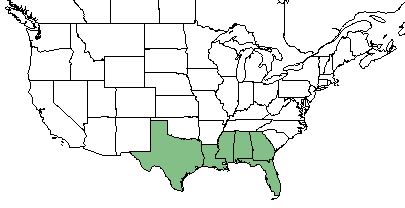Difference between revisions of "Agalinis pulchella"
Krobertson (talk | contribs) |
Krobertson (talk | contribs) |
||
| Line 23: | Line 23: | ||
==Description== <!-- Basic life history facts such as annual/perrenial, monoecious/dioecious, root morphology, seed type, etc. --> | ==Description== <!-- Basic life history facts such as annual/perrenial, monoecious/dioecious, root morphology, seed type, etc. --> | ||
| − | ''Agalinis pulchella'' is a dioecious annual forb.<ref name="USDA"/> It is dull green to purplish with stems 6-10 dm tall. Leaves are opposite, or sub-opposite, spreading, narrowly linear, acute, entire, with stems 2-3 cm long. Seeds are 0.5-0.7 mm long and broadly triangular to quadrangular.<ref name="Pennell 1929"/> Cotyledons | + | ''Agalinis pulchella'' is a dioecious annual forb.<ref name="USDA"/> It is dull green to purplish with stems 6-10 dm tall. Leaves are opposite, or sub-opposite, spreading, narrowly linear, acute, entire, with stems 2-3 cm long. Seeds are 0.5-0.7 mm long and broadly triangular to quadrangular.<ref name="Pennell 1929"/> Cotyledons are orbicular to orbicular-ovate and 0.8-1.3 mm wide and long.<ref name="Canne 1983">Canne JM (1983) The taxonomic significance of seedling morphology in ''Agalinis'' (Scrophulariaceae). Canadian Journal of Botany 61:1868-1874.</ref> Seeds have a striate-tuberculate radial wall.<ref name="Canne 1979">Canne JM (1979) A light and scanning electron microscope study of seed morphology in ''Agalinis'' (Scrophulariaceae) and its taxonomic significance. Systematic Botany 4(4):281-296.</ref> |
==Distribution== | ==Distribution== | ||
Revision as of 13:50, 14 July 2021
| Agalinis pulchella | |
|---|---|
| Scientific classification | |
| Kingdom: | Plantae |
| Division: | Magnoliophyta - Flowering plants |
| Class: | Magnoliopsida - Dicots |
| Order: | Scrophulariales |
| Family: | Scrophulariaceae |
| Genus: | Agalinis |
| Species: | A. pulchella |
| Binomial name | |
| Agalinis pulchella Pennell | |

| |
| Natural range of Agalinis pulchella from USDA NRCS Plants Database. | |
Common name: St. Mark's false foxglove[1]
Contents
Taxonomic Notes
Synonym: Gerardia pulchella Pennell.[2]
Description
Agalinis pulchella is a dioecious annual forb.[1] It is dull green to purplish with stems 6-10 dm tall. Leaves are opposite, or sub-opposite, spreading, narrowly linear, acute, entire, with stems 2-3 cm long. Seeds are 0.5-0.7 mm long and broadly triangular to quadrangular.[3] Cotyledons are orbicular to orbicular-ovate and 0.8-1.3 mm wide and long.[4] Seeds have a striate-tuberculate radial wall.[5]
Distribution
This species is found from Texas, eastward to Florida and Georgia.[1][3]
Ecology
Habitat
A. pulchella is found in pine savannas and sandhills of the southeastern United States.[2] It has also been described as occurring in dry open sandy longleaf-pinelands on the southeastern coastal plain.[3] It has also been observed in clearcut areas in a soil disturbed sand ridge. [6]
Phenology
In North America, this species flowers in September and fruits in October.[6][3]
Pollination and use by animals
Members of the Agalinis genus, including this one, host larvae of the common buckeye butterfly (Junonia coenia) in Florida.[7]
Conservation, cultivation, and restoration
Cultural use
Photo Gallery
References and notes
- ↑ 1.0 1.1 1.2 USDA NRCS (2016) The PLANTS Database (http://plants.usda.gov, 26 January 2018). National Plant Data Team, Greensboro, NC 27401-4901 USA.
- ↑ 2.0 2.1 Weakley AS (2015) Flora of the Southern and Mid-Atlantic States. Chapel Hill, NC: University of North Carolina Herbarium.
- ↑ 3.0 3.1 3.2 3.3 Pennell FW (1929) Agalinis and allies in North America: II. Proceedings of the Academy of Natural Sciences of Philadelphia 81:111-249.
- ↑ Canne JM (1983) The taxonomic significance of seedling morphology in Agalinis (Scrophulariaceae). Canadian Journal of Botany 61:1868-1874.
- ↑ Canne JM (1979) A light and scanning electron microscope study of seed morphology in Agalinis (Scrophulariaceae) and its taxonomic significance. Systematic Botany 4(4):281-296.
- ↑ 6.0 6.1 Florida State University Robert K. Godfrey Herbarium database. URL: http://herbarium.bio.fsu.edu. Last accessed: March 2019. Collectors: R. K. Godfrey and Roy Komarek. States and counties: Florida: Liberty. Georgia: Thomas.
- ↑ Observation by Roger Hammer in Silver Springs State Park, Marion County, FL. September 2016, posted to Florida Flora and Ecosystematics Facebook Group August 4, 2017.